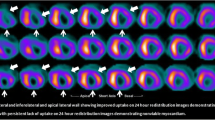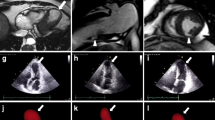Conclusions
Myocardial viability is a vital concept in the assessment of patients with cardiac dysfunction and coronary artery disease. Demonstrating viable myocardium alters management and prognosis for patients.
The amount of viable myocardium is proportional to the degree of improvement of ventricular function after revascularization. Improved survival occurs if early revascularization is performed once viability has been established. This case report illustrates a successful response to revascularization after 34 years of myocardial hibernation. Recurrent ischemia as a result of compression of the anomalous LMCA in the setting of nonsignificant epicardial coronary artery disease may serve as a potential mechanism for such a prolonged state of hibernating myocardium. Nevertheless, coronary revascularization, even after extended periods of myocardial hibernation, should be considered to afford improved survival. The choice of testing for myocardial viability is dependent on institutional availability, with PET scanning being the modality of choice. Nuclear scintigraphy and DSE are excellent alternatives.
Similar content being viewed by others
References
Chareonthaitawee P, Gersh BJ, Araoz PA, Gibbons RJ. Revascularization in severe left ventricular dysfunction the role of viability testing. J Am Coll Cardiol 2005;46:567–74.
Rahimtoola SH, La Canna G, Ferrari R. Hibernating myocardium: another piece of the puzzle falls into place. J Am Coll Cardiol 2006;47:978–80.
Di Carli MF Assessment of myocardial viability after myocardial infarction. J Nucl Cardiol 2002;9:229–35.
Di Carli MF, Hachamovitch R, Berman DS. The art and science of predicting postrevascularization improvement in left ventricular (LV) function in patients with severely depressed LV function. J Am Coll Cardiol 2002;40:1744–7.
Beanlands RS, Hendry PJ, Masters RG, de Kemp RA, Woodend K, Ruddy TD. Delay in revascularization is associated with increased mortality rate in patients with severe left ventricular dysfunction and viable myocardium on fluorine 18-fluorodeoxyglucose positron emission tomography imaging. Circulation 1998; 98(Suppl):1151–6.
Bax JJ, Schinkel, AF, Boersma E, Rizzello V, Elhendy, A, Maat A, et al. Early versus delayed evascularization in patients with ischemic cardiomyopathy and substantial viability: impact on outcome. Circulation 2003;108(Suppl 1):1139–42.
Allman KC, Shaw, LJ, Hachamovitch, R, Udelson JE Myocardial viability testing and impact of revascularization on prognosis in patients with coronary artery disease and left ventricular dysfunction: a meta-analysis. J Am Coll Cardiol 2002;39:1151–8.
Bax JJ, Visser FC, Poldermans D, Elhendy A, Cornel JH, Boersma E, et al. Time course of functional recovery of stunned and hibernating segments after surgical revascularization. Circulation 2001;104(Suppl 1):1314–8.
Rahimtoola SH The hibernating myocardium. Am Heart J 1989; 117:211–21.
Carluccio E, Biagioli P, Alunni G, Murrone A, Giombolini C, Ragni T, et al. Patients with hibernating myocardium show altered left ventricular volumes and shape, which revert after revascularization: evidence that dyssynergy might directly induce cardiac remodeling. J Am Coll Cardiol 2006;47:969–77.
Canty JM Jr, Suzuki G, Banas MD, Verheyen F, Borgers M, Fallavollita JA. Hibernating myocardium: chronically adapted to ischemia but vulnerable to sudden death. Circ Res 2004;94:1142–9.
Braunwald E, Kloner RA. The stunned myocardium: prolonged, postischemic ventricular dysfunction Circulation 1982;66:1146–9.
Samady H, Elefteriades JA, Abbott BG, Mattera JA, McPherson CA, Wackers FJ. Failure to improve left ventricular function after coronary revascularization for ischemic cardiomyopathy is not associated with worse outcome. Circulation 1999;100:1298–304.
Arrighi JA. Assessment of myocardial viability: more than measurements of radiotracer uptake alone. J Nucl Cardiol 2006;13: 180–3.
Travin MI, Bergmann SR. Assessment, of myocardial viability. Semin Nucl Med 2005;35:2–16.
Beller GA. Assessment of myocardial perfusion and metabolism for assessment of myocardial viability. Q J Nucl Med 1996;40:55–67.
Bax JJ, Poldermans D, Elhendy A, Boersma E, Rahimtoola SH Sensitivity, specificity, and predictive accuracies of various noninvasive techniques for detecting hibernating myocardium. Curr Probl Cardiol 2001;26:147–81.
Klocke FJ, Baird MG, Lorell BH, et al. ACC/AHA/ASNC guidelines for the clinical use of cardiac radionuclide imaging—executive summary: a report of the American College of Cardiology/American Heart Association Task Force on Practice Guidelines (ACC/AHA/ASNC Committee to Revise the 1995 Guidelines for the Clinical Use of Cardiac Radionuclide Imaging). Circulation 2003;108:1404–18.
Cornel JH, Bax JJ, Elhendy A, Maat AP, Kimman GJ, Geleijnse ML, et al. Biphasic response to dobutamine predicts improvement of global left ventricular function after surgical revascularization in patients with stable coronary artery disease: implications of time course of recovery on diagnostic accuracy. J Am Coll Cardiol 1998;31:1002–10.
Afridi I, Kleiman NS, Raizner AE, Zoghbi WA. Dobutamine echocardiography in myocardial hibernation. Optimal dose and accuracy in predicting recovery of ventricular function after coronary angioplasty. Circulation 1995;91:663–70.
Bonow RO. Identification of viable myocardium. Circulation 1996;94:2674–80.
Pagano D, Townend JN, Littler WA, Horton R, Camici PG, Bonser RS. Coronary artery bypass surgery as treatment for ischemic heart failure: the predictive value of viability assessment with quantitative positron emission tomography for symptomatic and functional outcome. J Thorac Cardiovasc Surg 1998;115:791–9.
Author information
Authors and Affiliations
Rights and permissions
About this article
Cite this article
Wissner, E., Mookadam, F. Thirty-four years of hibernating myocardium: A case report. J Nucl Cardiol 14, 745–749 (2007). https://doi.org/10.1016/j.nuclcard.2007.06.119
Issue Date:
DOI: https://doi.org/10.1016/j.nuclcard.2007.06.119




